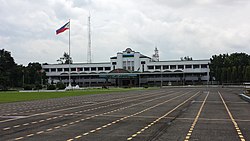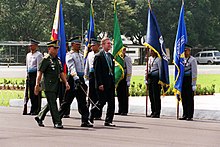
Emilio Aguinaldo y Famy was a Filipino revolutionary, statesman, and military leader who is the youngest president of the Philippines (1899–1901) and became the first president of the Philippines and of an Asian constitutional republic. He led the Philippine forces first against Spain in the Philippine Revolution (1896–1898), then in the Spanish–American War (1898), and finally against the United States during the Philippine–American War (1899–1901). Though he was not recognized as president outside of the revolutionary Philippines, he is regarded in the Philippines as having been the country's first president during the period of the First Philippine Republic.

The Philippine Constabulary was a gendarmerie-type military police force of the Philippines from 1901 to 1991, and the predecessor to the Philippine National Police. It was created by the American occupational government to replace the Spanish colonial Guardia Civil, happened on the 19th century history of the Philippines. It was the first of the four branches of the Armed Forces of the Philippines. On January 29, 1991, it was merged with the Integrated National Police to form the Philippine National Police.

Quezon City, also known as the City of Quezon and Q.C., is the most populous city in the Philippines. According to the 2020 census, it has a population of 2,960,048 people. It was founded on October 12, 1939, and was named after Manuel L. Quezon, the second president of the Philippines.

Ortigas Center is a central business district located within the joint boundaries of Pasig, Mandaluyong and Quezon City, within the Metro Manila region in the Philippines. With an area of more than 100 hectares, it is Metro Manila's second most important business district after Makati Central Business District. It is governed by Ortigas Center Association, Inc.

The Archdiocesan Shrine of Mary, Queen of Peace, also known as Mary, Queen of Peace Shrine, Our Lady of Peace Quasi-Parish and commonly known as the EDSA Shrine, is a small church of the Roman Catholic Archdiocese of Manila located at the intersection of Ortigas Avenue and Epifanio de los Santos Avenue (EDSA) in Barangay Ugong Norte, Quezon City, Philippines. It is a declared Important Cultural Property by the National Commission for Culture and the Arts.

Cainta, officially the Municipality of Cainta, is a 1st class urban municipality in the province of Rizal, Philippines. According to the 2020 census, it has a population of 376,933 people.

Camp General Rafael T. Crame is the national headquarters of the Philippine National Police (PNP) located along Epifanio de los Santos Avenue (EDSA) in Quezon City. It is situated across EDSA from Camp Aguinaldo, the national headquarters of the Armed Forces of the Philippines (AFP). Prior to the establishment of the civilian PNP, Camp Crame was the national headquarters of the Philippine Constabulary, a gendarmerie-type Military police force which was the PNP's predecessor.

Baras, officially the Municipality of Baras, is a 4th class municipality in the province of Rizal, Philippines. According to the 2020 census, it has a population of 87,637 people.

Santolan–Annapolis station, also simply known as Santolan station, is an elevated Metro Rail Transit (MRT) station located on the MRT Line 3 (MRT-3) system in Quezon City. It is the ninth station for trains headed to North Avenue and the fifth station for trains headed to Taft Avenue. The station is named after the streets it is situated in between Santolan Road and Annapolis Street, and near the eastern San Juan–Quezon City boundary.
General Mateo Noriel Luga, with the nom-de-guerre of Alimokon, was a Filipino revolutionary who left Isabela province to join the 1896-1898 Philippine Revolution in Manila. He also participated in the consequent Philippine–American War in Luzon but was later appointed in April 1899 by Philippine President Emilio Aguinaldo and then Secretary of War Antonio Luna to assist in the resistance in Cebu. In January 1900, Luga joined the last major battle to be fought openly in said island, the Battle of Sudlon. After the fall of Sudlon, Luga and most of the revolutionaries of Cebu resorted to guerrilla warfare against the Americans which would last until the surrender of Philippine President Emilio Aguinaldo in 1901.

Robinsons Galleria, is a mixed-use complex and shopping mall located at EDSA (C-4) corner Ortigas Avenue in Quezon City, Metro Manila, the Philippines. The mall is owned by Robinsons Malls, and it is their flagship mall. It is the first Robinsons Mall to bear the Galleria branding and was built on January 12, 1990, with a total gross floor area of approximately 216,000 m2 (2,330,000 sq ft).

The Roman Catholic Diocese of Cubao is a diocese of the western Latin Church of the Catholic Church in district of Cubao in Quezon City, in northern Metro Manila, Philippines. The diocese was created by Pope John Paul II on June 28, 2003 from the ecclesiastical district of Cubao of the Roman Catholic Archdiocese of Manila. It was canonically erected on August 28, 2003, with the installation of Honesto Flores Ongtioco as the first Bishop of Cubao. The Blessed Virgin Mary, under the title Immaculate Conception, is the principal patroness of the diocese.

Greenhills is an administrative division in eastern Metro Manila, the Philippines. It is an urban barangay in San Juan and is the largest barangay in the city, covering a total area of 2.09 square kilometers (209 ha) that spans over a third of San Juan's total land area.

Ortigas Avenue is a 12.1 km (7.5 mi) highway running from eastern Metro Manila to western Rizal in the Philippines. It is one of the busiest highways in Metro Manila, serving as the main thoroughfare of the metro's east–west corridor, catering mainly to the traffic to and from Rizal.

Aurora Boulevard is a four-to-ten lane major thoroughfare in Quezon City and San Juan in Metro Manila, Philippines. It was named after Doña Aurora Quezon, the consort of Commonwealth President Manuel Luis Quezon. It is one of the major roads in the commercial district of Araneta City in Cubao. Line 2 follows the alignment of the boulevard.
The People Power Revolution was a series of popular demonstrations in the Philippines that began in 1983 and culminated in 1986. The methods used amounted to a sustained campaign of civil resistance against regime violence and electoral fraud. This case of nonviolent revolution led to the toppling of dictator Ferdinand Marcos and the restoration of the country's democracy.

Colonel Bonny Serrano Avenue, formerly named and still colloquially known as and referred to as Santolan Road, is a major east–west thoroughfare in the Eastern Manila District of Metro Manila, Philippines, between San Juan and Quezon City. It forms the northern limit of San Juan and the southern limit of Quezon City's New Manila district. It also links the PNP headquarters in Camp Crame with the AFP headquarters in Camp Aguinaldo. The avenue runs from the border of barangays Corazón de Jesús, St. Joseph (Halo-Halo), Pasadena, and Little Baguio in San Juan to barangays Libís and Blue Ridge B near the Quezon City-Marikina border in the east. It was named after the decorated Korean War hero, Venancio "Bonny" Serrano.

The following is an alphabetical list of articles related to the Philippine capital region of Metro Manila.

Socorro is a barangay located in Quezon City, Philippines, within the commercial district of Cubao. As of the 2019 census, the barangay has a population of 25,073 people. The barangay is home to Araneta City and Smart Araneta Coliseum, one of the largest indoor arenas in the world.






















